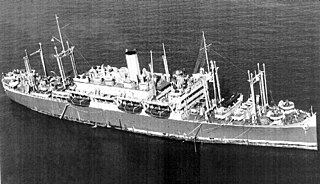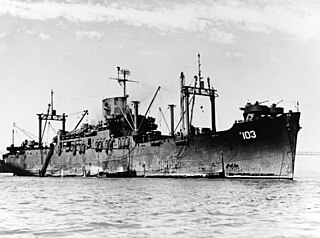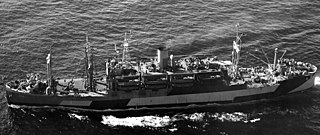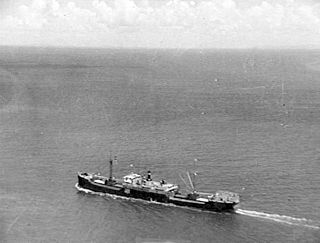
USS Pickaway (APA/LPA-222) was a Haskell-class attack transport that saw service with the US Navy in World War II, the Korean War and the Vietnam War. She was of the VC2-S-AP5 Victory ship design type and named after Pickaway County, Ohio.

USS Wharton (AP-7) was a troop transport in the service of the United States Navy during World War II. The ship was originally an Emergency Fleet Corporation Design 1029 type built for the United States Shipping Board. The ship was laid down as Manmasco but renamed and launched as Sea Girt then completed September 1921 as Southern Cross. The ship was first allocated by the United States Shipping Board to the Munson Steamship Line until purchased by the line in 1925. Munson operated the Southern Cross in the South American trade from 1921 until 1938 when the ship was sold at a Marshall's sale and taken over by the United States Maritime Commission which paid the full mortgage claim.

USS Hugh L. Scott (AP-43) was a Hugh L. Scott-class transport ship. She was built in 1921 and spent 20 years in merchant service as a passenger and cargo liner. In July 1941 the ship was delivered to the United States Department of War for Army service as the United States Army Transport Hugh L. Scott operating in the Pacific. In August 1942 the ship was transferred to the United States Navy for conversion to an attack transport, served as a troopship in Operation Torch in November 1942, and was sunk by a U-boat four days later. 59 crewmen and soldiers died during the sinking.

SS President Cleveland was originally built as Golden State for the United States Shipping Board (USSB), one of the planned World War I troop transports converted before construction into passenger and cargo vessels launched as Emergency Fleet Corporation Design 1029 ships first known, along with the smaller Design 1095 versions, in the trade as "State" ships due to names assigned for the nicknames of states and later as "535s" for their length overall. Almost all ships of both designs were renamed for United States presidents by May 1921, with Golden State being renamed President Cleveland. As one of the USSB-owned ships operated by agents of the board, President Cleveland was allocated to and operated by the Pacific Mail Steamship Company until sold by the USSB to the Dollar Steamship Line in 1925. After the demise of that line and creation of a new, replacement line, American President Lines, the ship remained with that line until government acquisition for the Second World War.

SS Munargo was a commercial cargo and passenger ship built for the Munson Steamship Line by New York Shipbuilding Corp., Camden, New Jersey launched 17 September 1921. Munargo operated for the line in the New York-Bahamas-Cuba-Miami service passenger cargo trade. In June 1930 the United States and Mexican soccer teams took passage aboard Munargo from New York to Uruguay for the 1930 FIFA World Cup. The ship was acquired by the War Shipping Administration and immediately purchased by the War Department for service as a troop carrier during World War II. Shortly after acquisition the War Department transferred the ship to the U.S. Navy which commissioned the ship USS Munargo (AP-20). She operated in the Atlantic Ocean for the Navy until returned to the War Department in 1943 for conversion into the Hospital ship USAHS Thistle.

USS President Polk (AP-103) was a President Jackson-class attack transport in the service of the United States Navy during World War II.

American Legion was built for the United States Shipping Board (USSB), one of the planned World War I troop transports converted before construction into passenger and cargo vessels, the Emergency Fleet Corporation Design 1029 ships. The ship was laid down as Koda and perhaps assigned the name Badger State at one point, but renamed American Legion before launch and one of only a few of the design not taking a state nickname. Originally operated by the USSB's agents and the Munson Steamship Line the ship saw commercial service until laid up 13 March 1939.

USS Harris (APA-2) was an Emergency Fleet Corporation Design 1029 ship launched for the United States Shipping Board (USSB) on 19 March 1921 by Bethlehem Shipbuilding Corporation, at Sparrows Point, Maryland as Pine Tree State. After operation by commercial lines for the USSB, during which the ship was renamed President Grant and operated commercially until laid up in the late 1930s.

USS Zeilin (APA-3) was an Emergency Fleet Corporation Design 1029 ship launched for the United States Shipping Board (USSB) on 19 March 1921 by Newport News Shipbuilding and Drydock Company in Newport News, Virginia as Silver State. After operation by commercial lines for the USSB, during which the ship was renamed President Jackson, the ship was purchased and operated commercially until laid up in the late 1930s.

USS Leonard Wood (APA-12) was built by Bethlehem Shipbuilding Corporation and launched 17 September 1921 at Sparrows Point, Maryland as Nutmeg State, an Emergency Fleet Corporation Design 1029 ship intended as a World War I troop transport, but redesigned upon the armistice as a passenger and cargo ship and completed as Western World for delivery to the United States Shipping Board. The ship's acceptance on 5 May 1922 and delivery on 9 May 1922 marked the completion of the wartime shipbuilding program of the Emergency Fleet Corporation and the Shipping Board.

USS Henry T. Allen was a Harris class attack transport in service with the United States Army from 1940 to 1941. She was then transferred to the United States Navy where she served until 1946. She was scrapped in 1948. The ship was originally built as an Emergency Fleet Corporation Design 1029 ship in 1919 and operated in commercial service as Wenatchee and President Jefferson until being laid up in 1938.

USS J. Franklin Bell (APA-16) was a Harris-class attack transport ship. She was built in 1921 and spent 20 years in merchant service as a passenger and cargo liner. She was acquired for the United States Army in 1940 and transferred to the United States Navy shortly after the USA entered the Second World War. She served throughout and after the Pacific War, was decommissioned in 1946 and scrapped in 1948.

USS Tuluran (AG-46) was under construction for the British at the Toledo Shipbuilding Company as the cargo ship War Bayonet in 1917 when requisitioned by the United States Shipping Board (USSB) for World War I service. The ship was launched and completed as Lake Superior. The Navy acquired the ship from the USSB with assignment to the Naval Overseas Transport Service (NOTS) with the identification number ID-2995. The ship was returned to the USSB which sold the vessel in 1926. The ship was renamed C. D. Johnston III and that vessel operated out of Oregon until again sold and based in San Francisco. Another sale resulted in the vessel being renamed Anna Shafer which was acquired by the War Shipping Administration (WSA) in 1942 and allocated to the Navy for World War II service.

MS West Honaker was a diesel-powered cargo ship of the United States Maritime Commission (USMC) that was part of the "Corncob Fleet" of old ships sunk as part of the "gooseberry" breakwater off Utah Beach during the Normandy invasion. The ship was originally built as SS West Honaker, a steam-powered cargo ship built for the United States Shipping Board (USSB), a predecessor of the USMC. At the time of her completion in 1920, the ship was inspected by the United States Navy for possible use as USS West Honaker (ID-4455) but was neither taken into the Navy nor ever commissioned under that name.

President Taylor was a cargo-liner, ex President Polk, ex Granite State, requisitioned for war service in December 1941 and allocated by the War Shipping Administration (WSA) to the U.S. Army and operating as a troopship in the Pacific Ocean in World War II when grounded and eventually lost on 14 February 1942.

USAHS Marigold was a United States Army hospital ship during World War II. The ship was built as Old North State in 1920 for the United States Shipping Board as a civilian passenger/cargo liner. The ship changed ownership and operating companies several times with name changes to President Van Buren and President Fillmore before being acquired for military transport service in 1941. After government acquisition during World War II President Fillmore served as a War Shipping Administration troop transport before conversion to hospital ship service.

SS President Taft was launched as one of the "state" ships, Buckeye State, completed by the United States Shipping Board as cargo passenger ships after originally being laid down as troop transports. Buckeye State had been laid down as Bertrice but was converted and renamed before launching. Originally assigned to the Matson Navigation Company as the Shipping Board's agent, the ship was later renamed President Taft and assigned to Pacific Mail Steamship Company for operation. In 1925 the Shipping Board sold the ship to Dollar Steamship Company. President Taft was operated by Dollar and then its successor American President Lines until requisitioned by the War Department on 17 June 1941.
The Design 1095 ship was an Emergency Fleet Corporation (EFC) design for a troop transport to be built at New York Shipbuilding Corporation and delivered to the United States Shipping Board (USSB) that, at the end of World War I hostilities, was modified to a combined passenger and cargo vessel. The contract was for thirteen ships, EFC hulls 2579 though 2591, but later adjusted to seven ships with the remainder being changed during construction to the slightly larger ships of EFC Design 1029 built from the start as passenger and cargo ships rather than being modified from the troop ship plan.

Wolverine State was a steam passenger-cargo ship built in 1919–1920 by New York Shipbuilding Company of Camden for the United States Shipping Board (USSB) as part of the wartime shipbuilding program of the Emergency Fleet Corporation (EFC) to restore the nation's Merchant Marine. The ship was initially employed on the United States to India route until its cancellation in Spring 1922. After remodeling the vessel was briefly used by the Los Angeles Steamship Company on a run between Los Angeles and Honolulu as an emergency replacement for one of their burned out steamers. In April 1922 the steamer was renamed President Harrison. In 1923 she conducted several trips between California and the east coast of South America, before being sold together with several other ships of her class to the Dollar Steamship Company. The vessel was captured in 1941 by the Japanese after she was deliberately run aground to avoid the capture. After repairs, the ship was renamed Kachidoki Maru (勝鬨丸), put under control of NYK Line and entered the Japan to Taiwan route, but soon after was requisitioned by the Imperial Japanese Army. Under IJA control the ship sailed between Japan, Singapore and the Philippines carrying troops and military supplies. She was torpedoed and sunk on 12 September 1944 on one of her regular trips, while carrying 950 Allied prisoners of war of which 431 were killed.
West Hika was a Design 1013 cargo ship built in 1919 by the Los Angeles Shipbuilding & Dry Dock Co of Los Angeles. She was one of many ships built by the company for the United States Shipping Board.



















